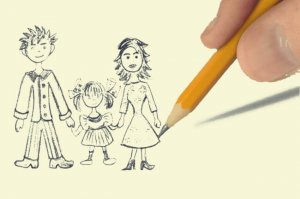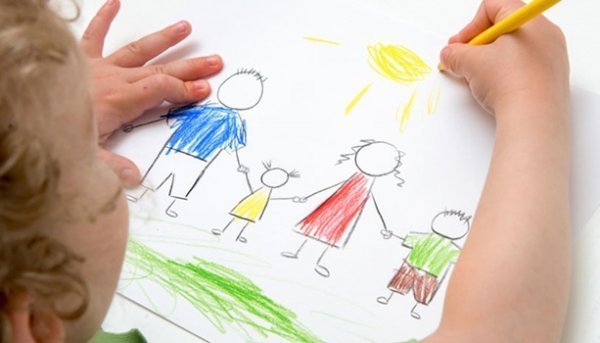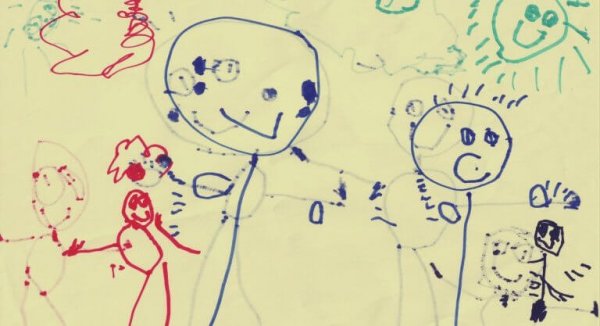The Family Drawing Test


Written and verified by the psychologist Valeria Sabater
The family drawing test is one of the most well-known emotional evaluations for children. It gives an understanding of how the child or adolescent perceives their closest relationships. It’s a simple way to understand the quality of the relationships and communication, and how children construct their reality based on family relationships.
This diagnostic test has been around for over six decades. Psychiatrist Miles Porot created it in 1951 and it’s now one of the most common tools used to evaluate the personalities of children between 5 to 16. Although there are professionals today who doubt the reliability of projective techniques like the tree test or the family drawing test, their validity is well-researched.
“One of the luckiest things that can happen to you in life is to have a happy childhood.”
-Agatha Christie-
It is important to mention that doctors use this test along with other, more standardized methods. Interviews, tests, and evaluations such as this one all together can provide enough information for an accurate diagnosis. In fact, this particular evaluation is getting better every year. It’s a simple, quick way to better understand children’s feelings, family relationships, and emotional maturity.

What is the goal of the family drawing test?
As you probably already know intuitively, drawing is and always will be a symbolic place where children reveal a lot about themselves. Drawing and play are two ideal resources for psychological diagnosis of children. That’s why the family drawing test is a useful resource for all child psychologists and therapists. It can help health professionals achieve the following objectives:
- Understand the problems that the child or adolescent is having in their family.
- Reinforce the quality of emotional bonds.
- See how they view their family relationships and how they feel about them.
- Identify possible conflicts with certain members of the family.
- Evaluate the emotional and psychological maturity of the child or adolescent.
- Evaluate the family’s communication style.
- Find out what the child or adolescent is worried about at home.
It’s also important to mention that the most important thing about this test is the emotional aspect. The evaluation isn’t just trying to get the patient to draw something. Instead, the health professional should foster comfortable, fluid dialogue with the child while they draw. The child should be opening up, line by line. In short, the act of drawing should help the child release their feelings, emotions, and worries.

How do therapists use the family drawing test?
Therapists and psychologists use the family drawing test in the following way:
- First, they offer the child a piece of paper and colored pencils.
- The environment should be comfortable. The child should feel safe and secure.
- Next, they tell the child or adolescent to draw their family.
- They tell the child that the drawing will not be graded. The idea is for them to be relaxed while drawing. If they enjoy the experience, even better.
- Later, once figures begin to take shape, the therapist can start to ask questions.
- One way to get more information during the test is to ask the following questions: Who is this? What do they do? Do you get along with him/her? Who is the happiest? Who is the most unhappy?
It is also important that the psychologist note the order in which the child creates different elements of their drawing. Additionally, they should also indicate if the child erases anything, crosses something out, hesitates, etc.
How do healthcare providers evaluate the test?
In the beginning, the family drawing tests had a psychoanalytical focus. Consequently, for years the analysis of the test was done through an Oedipus lens or Freud’s stages of psychosexual development. Today, the interpretation is more standardized. Therapists use statistical information as well as the personal situation of each child or teen.
Here are some of the guidelines for evaluating the family drawing test:
- Size and place. Large drawings denote safety and security. In contrast, small figures stuck in a corner show fear and insecurity.
- Curves and straight lines. Drawings with angles and curves show energy and maturity. Drawings with few shapes and/or stereotypical and rough figures, on the other hand, show immaturity and inhibition.
- Order and distance. One aspect that therapists should evaluate is the order in which the child draws each figure. Children usually draw the mother first, or whoever they feel closest to emotionally. Another important detail to evaluate is the distance that the child leaves between different people in the drawing.
- The omission of certain figures. One common pattern is that some children choose not to draw themselves into the nuclear family. This is something that is important to evaluate and keep in mind. Likewise, the omission of one of the parents or siblings can symbolize rejection.

Lastly, remember that therapists don’t rely solely on the family drawing test to make a diagnosis. But when used in conjunction with interviews and other standardized tests, it provides enough information for a more accurate and concrete evaluation.
To sum up, this tool, like any other projective test, is a window into a child’s emotions and drawing is the means. In front of a blank page, children feel free to express fear, worry, and other underlying problems.
This text is provided for informational purposes only and does not replace consultation with a professional. If in doubt, consult your specialist.








